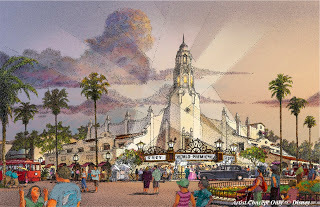Sam Gennawey's Blog, page 26
January 17, 2012
Whoops
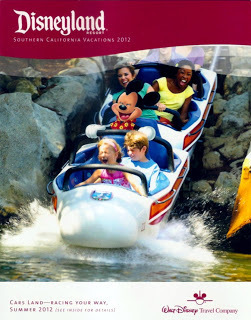
I recently picked up this 2012 promotional piece for the Disney Resort. I had to chuckle because the featured attraction, the Matterhorn Bobsleds, is going to be closed for big chunk of the year and they are showing the now obsolete sleds. And is Mickey standing?
January 16, 2012
Panorama: Maharajah Jungle Trek
January 14, 2012
Disney Podcast Online with guest Sam Gennawey

Happy to announce that I was a guest on the Disney Podcast with Dave Kennedy and I invite you to download a really fun discussion.
January 12, 2012
Why I Love the Matterhorn
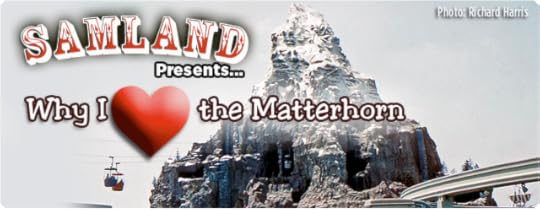
The Matterhorn Bobsled attraction at Disneyland opened to much fanfare on June 14, 1959. I entered the world a couple of months later to far less attention. In my head, I feel a special connection and I am reminded that I am as old as a mountain. As some of you may know, I will be speaking at The Walt Disney Family Museum, along with Ron Miller and David Price, talking about Walt's vision for a ski resort called Mineral King. Because of this, I have the Matterhorn firmly placed in the front of my mind.
READ MORE AT MICECHAT
January 11, 2012
SOON....
January 10, 2012
Disney's Hollywood Studios - Hollywood and Sunset Boulevard
I have always been fascinated by Disney's Hollywood Studios (DHS). The idea for this park was launched in 1985 and for the first time a Disney theme park was opened merely to fit a business need. The park would be a model of controlled growth in reaction to anticipated demand.
DHS opened in 1989 and was originally known as the Disney-MGM Studios. It was designed to be a half-day experience and to compliment a visit to Typhoon Lagoon and Pleasure Island. Disney CEO Michael Eisner took a look at what the Imagineers were up to and noticed a large-scale pavilion that was going to celebrate the cinema for EPCOT's Future World. That pavilion would have been located between the Land and the Imagination Pavilions. He encouraged his Imagineers to expand on the idea and create a third gate. What they created was a tiny park with a handful of attractions. DHS is only 85 acres or the size of Disneyland. This would be a much smaller park then the Magic Kingdom or EPCOT. The Imagineers wanted to capture Disneyland's "human scale, warmth, and feeling."
The facility would also function as a real production studio with three sound stages, production offices, and a postproduction audio and video facility; its own wardrobe, property, camera, and lighting departments. The production facilities featured glass walls so that visitors could peek inside a working movie-making facility. Projects shot on the back lot include Honey, I Blew Up the Kids, Passenger 57 and TV shows like The Mickey Mouse Club and Wheel of Fortune.
Most of the Disney theme parks are based on the Disneyland model. You go big. As big as you can afford. Disneyland, the Magic Kingdom, EPCOT, Tokyo Disneyland, Disneyland Paris, and Tokyo DisneySea are directly related. DHS represents a new formula for designing and operating a theme park that has had significant influence on the Disney empire.
The placed was packed on day one and it became necessary to expand the park rapidly. The immediate success of DHS set the stage for such parks as Disney's California Adventure, Hong Kong Disneyland, and Walt Disney Studio's in Paris. Instead of fully realized, immersive environments, with monstrous budgets, the Studios pointed toward a sort of MBA solution – a just in time theme park. Build it small and quickly add capacity as necessary. You see evidence of this even as you arrive to the front gate.
DHS was the first park built with the bus system in mind. At both the Magic Kingdom and EPCOT, the buses are tucked away to the side. At DHS, the buses are prominent and at the entry plaza and the auto-parking shuttle further complicates pedestrians' access. You can also arrive by one of the slowest moving boats known to mankind.
The main axis orientation is not true to north south like the other parks. I find the first impression to be a mess that only sorts itself out once you are standing at the turnstiles. Walking through the main gates feels like a period Hollywood postcard coming to life with the bonus of a time travel tour of iconic Los Angeles architecture. Inspired by the early filmmakers who used the real Los Angeles as the background for their movies, the Imagineers used the impressions from real building facades and billboards to tap into what Imagineer John Hench said was a "glamorous, dreamlike Hollywood of the collective consciousness."
Thematically, DHS represents "not a place on a map, but a state of mind" the "Hollywood that never was - and always will be." A visual trick that is used throughout DHS is called "shrink and edit." They take a real building as inspiration and then they change the scale, color or details in order to support the story they are trying to tell. Hollywood and Sunset Boulevards are filled with such examples.Once you step on to Hollywood Boulevard, you become immersed in an environment that is as rich as the Main Streets at Disneyland and the Magic Kingdom. The first structure you encounter is a scale model of the entrance to the Pan-Pacific Auditorium. This iconic building was Los Angeles's primary convention center from 1935 to 1972. The Pan-Pacific Auditorium was where all of the big shows, conventions, the circus, and other exhibitions were presented. It is a wonderful example of the Streamline Moderne style. Walt's good friend designed the building, architect Welton Beckett. Sadly, in 1989, just 3 weeks after DHS opened, the Pan-Pacific Auditorium burnt down in a spectacular fire.
The front plaza is at the intersection of Prospect and Hollywood Boulevards. This perfectly describes the optimistic spirit of Hollywood during its heyday and the theme park that lies beyond. On the right, after entering, is Oscar's Service Station. This facility is named after the famous Hollywood statue and this is where you can rent your wheeled vehicle, naturally. A fan favorite is the 1938 Darkroom Building. Once again, a real life structure is the inspiration for what Bob Gurr calls "California Corny."
In the middle of the plaza is a kiosk based on the Crossroads of the World building. The original was built in 1936 and is considered America's first outdoor mall. The DHS version is much, much smaller and is topped by a 5'3" Mickey with one copper ear that works as a lightning rod.
Sid Cahuenga's One-of-a-Kind is an excellent example of the California Bungalow done in the Arts and Crafts architectural style. It is inspired by the true story of the Janes House. The homeowner was offered a chance to sell his home to a shopping mall developer but the guy held out and didn't want to sell. Frustrated, the shopping mall developer went ahead and built the mall around his house. He decided to cash in by selling souvenirs. The house and mall are still around.
By the way, the reference to Sid is a tribute to Sid Grauman of Grauman's Chinese Theater fame. The Cahuenga refers to a pass through the hills near the Hollywood Bowl that connects the Los Angeles basin to the San Fernando Valley (and the Disney Studios).
Other buildings on Hollywood Boulevard include an electric substation (1907) from Culver City that is now a performance space, the Blaine Building (1926), a J.J. Newberry (1928), a bank on Wilshire Boulevard (1929), the Chapman Market (1929), Max Factor Building (1931), Owl Drug Store (1933), the Darkroom (1938), and many, many others. A highlight of the area is The Hollywood Brown Derby (1929), which is a treasure inside and out. Werner Weiss of Yesterland became obsessed by this and went through a lot of trouble to identify each of the building here, here and here.
The Imagineers use billboards to support a mythology of the Southern California experience promoted by real estate developers. Rarely has the region lived up to the hype.
If you look on top of the bank façade you see a billboard celebrating the Pacific Electric Railroad "Red Cars." This rail network was a vast system (see the map on the back side of the information booth) that connected all points within the Los Angeles area well into the early 1960s. Evidence of the Red Cars can be found on Sunset Boulevard as well. Notice trolley tracks left half uncovered below your feet. These were laid in anticipation of a major Roger Rabbit themed expansion that would have included the Toontown Trolley Ride, Herman's Runaway Buggy Ride, and the Benny the Cab attraction that ended up at Disneyland. As you recall, the demise of the Red Car system was at the heart of Who Framed Roger Rabbit.
Across the way are two more billboards. The billboards establish the architectural timeframe for Hollywood and Sunset Boulevards as well as Echo Lake (1923-1945). The Hollywoodland billboard refers to an early residential subdivision that opened in 1923. This date has special meaning, as it was the year Walt Disney moved to California. Nearby is another billboard for the 1945 Hollywood Canteen. This entertainment palace was an oasis for soldiers fighting in World War II.
Sunset Boulevard and Echo Lake are based on the same design principles as Hollywood Boulevard. Those areas have been restricted to facades of historic buildings from Los Angeles built before 1945 with one exception. One of the most important is the Carthay Circle Theater (1926) where Snow White and Seven Dwarfs premiered in 1937. Down the block, the spiral marquee belongs to the Academy Theater (1938) in Inglewood. There are two building from Pasadena, the Winter Garden (1940) and a bar called the 35er. Sunset Ranch Market is based on Los Angeles's famous Farmers Market (1941).
Throughout the front part of DHS you will tend to find buildings based on two styles of architecture, Art Deco and Streamline Moderne. Deco uses geometric designs, bold colors and modern materials and combines them to be elegant and make an optimistic statement. Streamline Moderne is a style that celebrates the machine age and is influenced by modern aerodynamic designs. Sweeping curves, symmetry, and repetition are part of the design language. Imagineer John Hench said the use of these distinctive and familiar architectural styles gives the park "archetypal truths." The stylized buildings are out of context and the scale is different but you accept that you could be in Hollywood set in the 1930s because all of the visual clues add up and create the underlying emotional appeal.
Here is a piece of trivia. Once upon a time, DHS was home to the world's largest hidden Mickey. Echo Lake was one ear, the large circular plaza in front of Grauman's Chinese Theater was the head, and there was a matching circular plaza to the east. Planters gently suggested the eyes. If you get a chance to see an aerial photo it become quite obvious. The addition of Sunset Boulevard and Mickey's hat destroyed this bit of fun.
January 9, 2012
Imaginerding: Walt and the Promise of Progress City, a Book Review
Panorama: The French Pavilion
January 8, 2012
Sam Gennawey on WEDWay Podcast - Adventureland in Disneyland

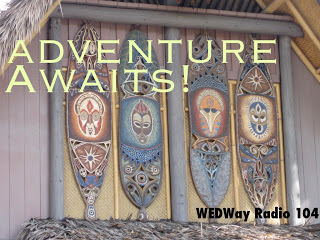
Thank you Matt and Nate for inviting me to be a guest on the excellent WEDWay Radio Podcast. We took a detailed look at one of my favorite spaces - Disneyland's Adventureland. You can download the episode via the link below or on iTunes. A fun recording.
GO HERE TO LEARN MORE AND TO DOWNLOAD
January 6, 2012
I will be selling and signing copies of Walt and the Prom...
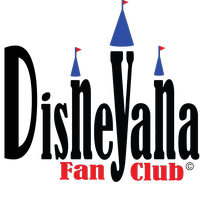 I will be selling and signing copies of Walt and the Promise of Progress City at the ALL DISNEYANA SHOW AND SALE
I will be selling and signing copies of Walt and the Promise of Progress City at the ALL DISNEYANA SHOW AND SALEHope to see you there.
SUNDAY, JANUARY 15, 2012
9:00a FOR DFC MEMBERS10:30a FOR THE REST OF THE WORLDOpen until 5p
Anaheim Crowne Plaza Resort12021 Harbor Blvd.Garden Grove
Go here for tickets



